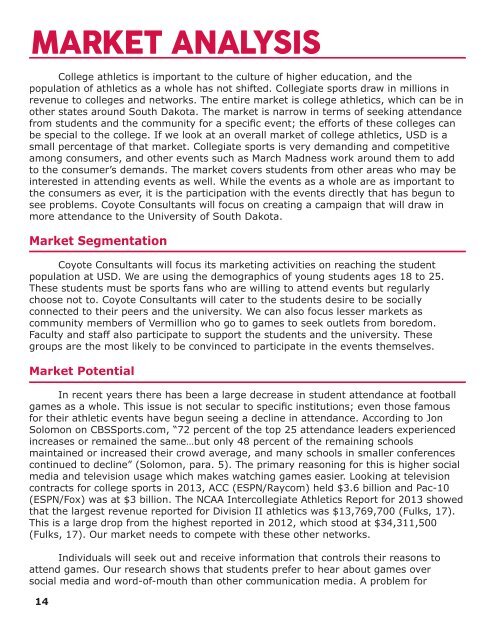CONSULTANTS
You also want an ePaper? Increase the reach of your titles
YUMPU automatically turns print PDFs into web optimized ePapers that Google loves.
MARKET ANALYSIS<br />
College athletics is important to the culture of higher education, and the<br />
population of athletics as a whole has not shifted. Collegiate sports draw in millions in<br />
revenue to colleges and networks. The entire market is college athletics, which can be in<br />
other states around South Dakota. The market is narrow in terms of seeking attendance<br />
<br />
be special to the college. If we look at an overall market of college athletics, USD is a<br />
small percentage of that market. Collegiate sports is very demanding and competitive<br />
among consumers, and other events such as March Madness work around them to add<br />
to the consumer’s demands. The market covers students from other areas who may be<br />
interested in attending events as well. While the events as a whole are as important to<br />
the consumers as ever, it is the participation with the events directly that has begun to<br />
see problems. Coyote Consultants will focus on creating a campaign that will draw in<br />
more attendance to the University of South Dakota.<br />
Market Segmentation<br />
Coyote Consultants will focus its marketing activities on reaching the student<br />
population at USD. We are using the demographics of young students ages 18 to 25.<br />
These students must be sports fans who are willing to attend events but regularly<br />
choose not to. Coyote Consultants will cater to the students desire to be socially<br />
connected to their peers and the university. We can also focus lesser markets as<br />
community members of Vermillion who go to games to seek outlets from boredom.<br />
Faculty and staff also participate to support the students and the university. These<br />
groups are the most likely to be convinced to participate in the events themselves.<br />
Market Potential<br />
In recent years there has been a large decrease in student attendance at football<br />
<br />
for their athletic events have begun seeing a decline in attendance. According to Jon<br />
Solomon on CBSSports.com, “72 percent of the top 25 attendance leaders experienced<br />
increases or remained the same…but only 48 percent of the remaining schools<br />
maintained or increased their crowd average, and many schools in smaller conferences<br />
continued to decline” (Solomon, para. 5). The primary reasoning for this is higher social<br />
media and television usage which makes watching games easier. Looking at television<br />
contracts for college sports in 2013, ACC (ESPN/Raycom) held $3.6 billion and Pac-10<br />
(ESPN/Fox) was at $3 billion. The NCAA Intercollegiate Athletics Report for 2013 showed<br />
that the largest revenue reported for Division II athletics was $13,769,700 (Fulks, 17).<br />
This is a large drop from the highest reported in 2012, which stood at $34,311,500<br />
(Fulks, 17). Our market needs to compete with these other networks.<br />
Individuals will seek out and receive information that controls their reasons to<br />
attend games. Our research shows that students prefer to hear about games over<br />
social media and word-of-mouth than other communication media. A problem for<br />
14


